Description
- Highly portable design-foldable solar suticase small in size, provide more flexibility for outdoor and off-grid use, easy to carry, store and set up.
- Remarkable efficiency- Renogy solar panels using grade A plus monocrystalline solar cells, providing ideal output: 500 Watt-hours per day (depends on sunlight availability).
- Reailable quality- coming with a premium rugged canvas protective case, heavy-duty handle, and latches for longevity.
- Work with power stations- this solar suitcase is able to charge suited power stations directly available.
- Safety guarantee- the low-voltage system avoids electric shock hazards to ensure the safety of usage.
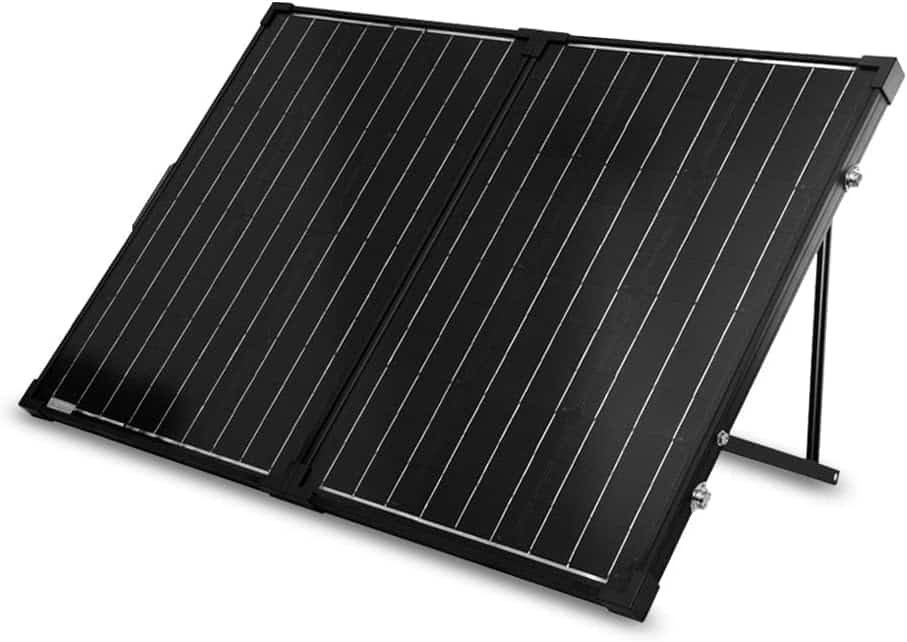
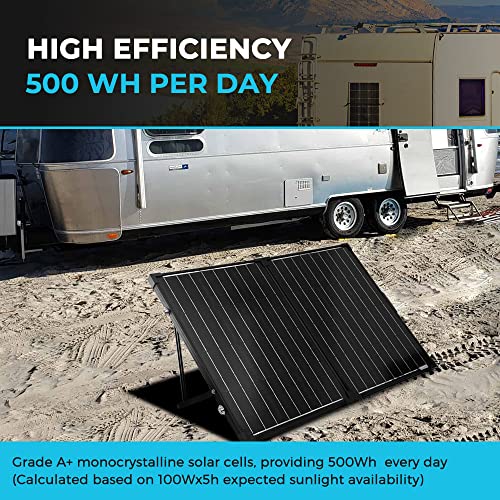
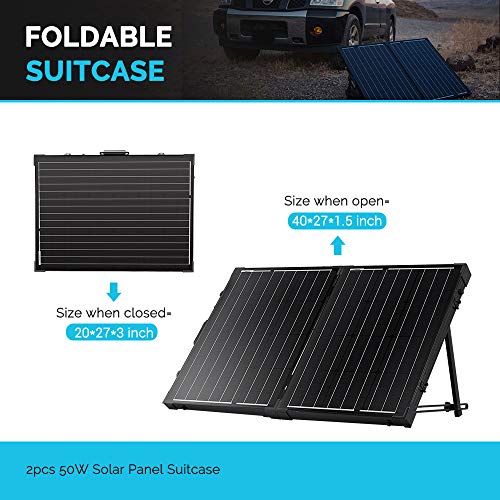
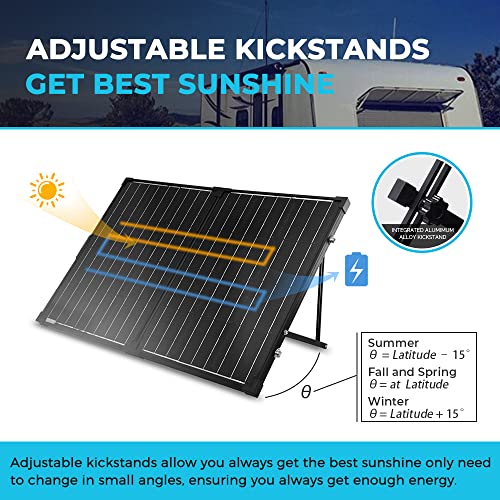
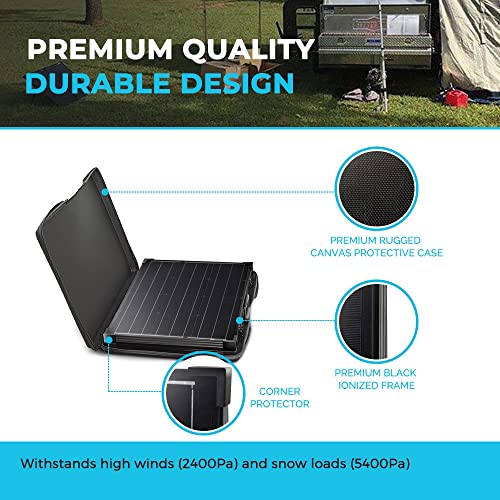
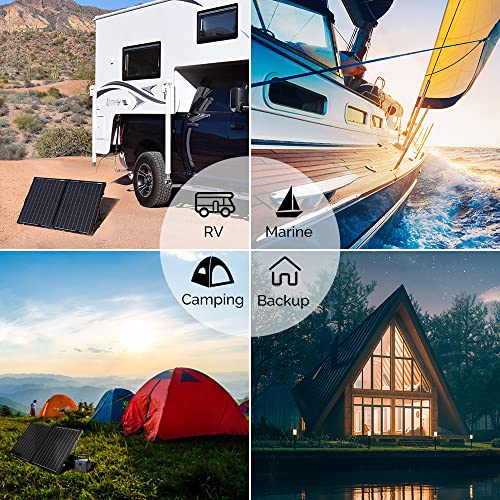
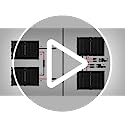
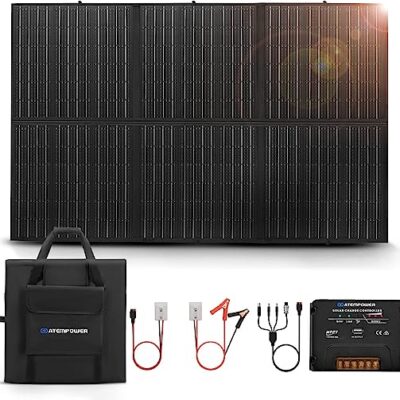
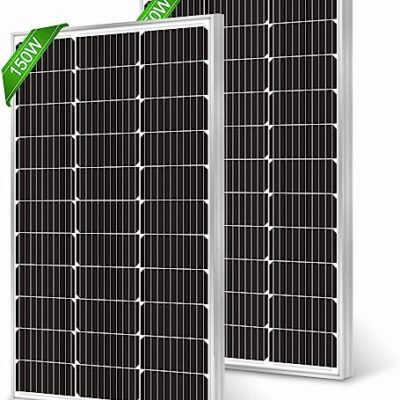
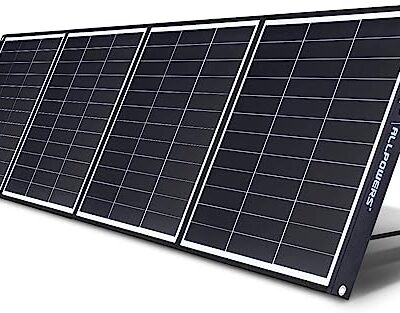
Kurt Nall –
I already had the 100 W solar suitcase from Renogy, and it was not quite enough to keep the 105 AH battery in our camper fully charged when running the small refigerator and keeping all our devices charged. Adding this panel worked out great, just had to buy a ‘Y’ cable to connect the panels in parallel in front of the controller. So far we have been very satisfied with the quality and functionality of Renogy products.
Rocks –
Update a few months later: I still think this is a quality product EXCEPT for the end of the pivot down legs. They have a plastic piece that is supposed to be a cushion foot so to speak but it always comes off and then the stand basically comes apart there. It’s a hassle each time to loosen the nut, insure tge washer is out of the way, slide the nut in the channel and tighten again.
It’s an easy factory fix they just need to rivet that piece in or put a screw in it or something to keep it from falling off so that the nut inside the channel cannot keep sliding out. Or they could simply use a good adhesive to keep the foot in place. That’s probably what I’m going to do.
Other than that I’m still happy with this Renogy suitcase panel.
Original review: Set this Renogy 100watt “suitcase” panel up in my driveway, immediately produced 103 watts which is better than my Rich Solar rigid panels in the same ideal conditions (90-93w max). I tried 100watt and 120watt soft folding panels off amazon and they each barely produced over 60 watts in the same ideal conditions.
This Renogy is a nice quality suitcase panel with quality latches, good rack system, and the padded case is nice too, (though it would be great if the added a shoulder strap to the case). I’d give 5 stars but it is a bit on the heavy side. But I suppose that’ll be a plus in windy conditions. Overall I highly recommend this panel 👍🏽👍🏽
MaLa –
Très satisfait de ce produit ,il me sert pour recharger une batterie portable .
En plein soleil c est 60 a 70% ,temps couvert c est a peu près 7 a 10% eh oui manque de clarté,normal ,il est pliable ,et se porte partout ,par terre ou sur le toit du véhicule ,en tout cas je ne regrette pas mon achat ,il est monocristallin .
Just Another Traveler –
I like renogy solar panels very much. It get about 80 watts in perfect conditions. This has always been my dependable back up. Wayyyyy more reliable than Jackery panels! But this thing is very heavy. In that, it is awkward and clumsy to set up. I ended up buying their Eflex 120 to replace it. I’m happier with that. And the track around the back of this always seem to fill p with dirt and gravel. Sigh… more work.
I’m sure all solar will end up in that direction.
J. Cheung –
I first turned to Renogy at the suggestion of a friend who bought a 100 watt, non-briefcase panel for the top of his car for overlanding. He spoke about the value proposition (longer warranty, better pricing) than Goal Zero (GZ) which was significant because we both work for a company that extends an employee discount on the product we sell.
We use this to charge a Goal Zero Yeti 500X when we aren’t charging it by AC or DC in the car. (We use the GZ Yeti to power our Dometic CFX3 55IM, Joolca hot water system, and/or personal electronics and lighting during power outages.) What I really like about this product is that it’s easier to get back into the bag compared to GZ’s version called the Boulder. Also, it has adjustable legs which lets you optimize the angle you need for the time of day or location which GZ doesn’t have. On a clear summer day in the San Francisco Bay Area, I have seen this panel input 98 watts which is incredible. Some solar panels don’t get that close to what’s advertised. This panel doesn’t completely crap out if some shade hits it and recovers nicely.
My only complaint is that it’s a little large and heavy. It’s portable enough to slide into our SUV but it can be heavy and awkward to maneuver for some people but that is the trade off given the price and value proposition. At higher price points, you could get 200-300 watt panels with the same footprint or weight. Overall, I highly recommend this item if your usage is similar to ours.
commander –
Je n’ai pas encore pu tester le panneau, mais le contrôleur de charge est manquant.
Antoine –
Après quelques semaines passées exposé aux intempéries, des points de rouilles apparaissent sur les rivets et les charnières.
Dommage que ce produit ne soit pas conçu pour rester à l’extérieur.
Top362nd –
I’m very impressed with this. I bought the “without controller” model because I wanted to use it with a Goal Zero Sherpa 100 and a Goal Zero Extreme 350 battery, both of which have built-in charge controllers. I already have the Goal Zero MC4 to 8mm adapter cable that allows this to connect directly to the batteries. Connected to the Sherpa 100 between 5:00 PM and 7:00 PM on a late August day here in Ohio I got a constant 45 watts, except when a dark cloud blocked the sun. The Sherpa 100 charge controller will only accept 45 watts so that was a successful test. The next day (today) I connected the panel to the Extreme 350 battery, which is rated to accept up to 150 watts maximum. It was around 5:00 PM so the sun was not directly overhead, but I was able to get 78 watts to this battery. I have a bendable 50 watt panel from Suaoki which I put at the same angle at the same time, using the same meter and going to the same battery, and the best it could do was 33 watts, sos the two Renogy 50 watt panels that make up this pair definitely did better. (33 watts for the 50w Suaoki and 39 watts each for the two 50w Renogy panels that make up the solar suitcase.)
I like the built-in stand, but to be clear it won’t stand the panel up straight enough to point directly at the sun after around 4:00 PM (at least on an August day in central Ohio). I expect that is because when it is too upright it becomes less stable and any breeze from the back could tip it forward. I braced it up in a more vertical position with a lawn chair but you could also put something under the feet. I understand why they did this but I choose to work around it. I think I might rig a little guy line and stake it out to the rear in the evening so it can’t fall forward onto the panel when I have it braced up higher than intended.
It is very solid and there were no defects in workmanship. Many people have complained about the latches, and they do seem a bit flimsy, but I’m not predicting they will break For all I know they will last as long as the panel. I’m very happy with this and highly recommend the “no controller” model for use with Goal Zero Yeti and the older Extreme batteries. It works well with my Goal Zero Sherpa 100 as well, as long the buyer understands that the battery is never going to take more than 45 watts. (I don’t have a Sherpa 50 battery, but I believe the controller in that one will only accept 30 watts.)
Rocks –
Using it directly to my RV outside solar connection. No additional regulator required. Cranks out some decent Ahr when the sun is out. Combined with original roof 140W panel does the job. Heavy, but sturdy.
C. Neill –
Muy bueno para acampar. Estable
Antoine –
Je viens de tester le panneau solaire, et celui ci n’apporte que 0,4 ampères, quand il devrait faire 4 ampères minimum. 100 watts à 12v = 4 ampères.
J’ai essayé avec le soleil en direct sur le panneau 0,4 ampères, et a l’ombre 0,1 ampères.
Je suis vraiment déçu.